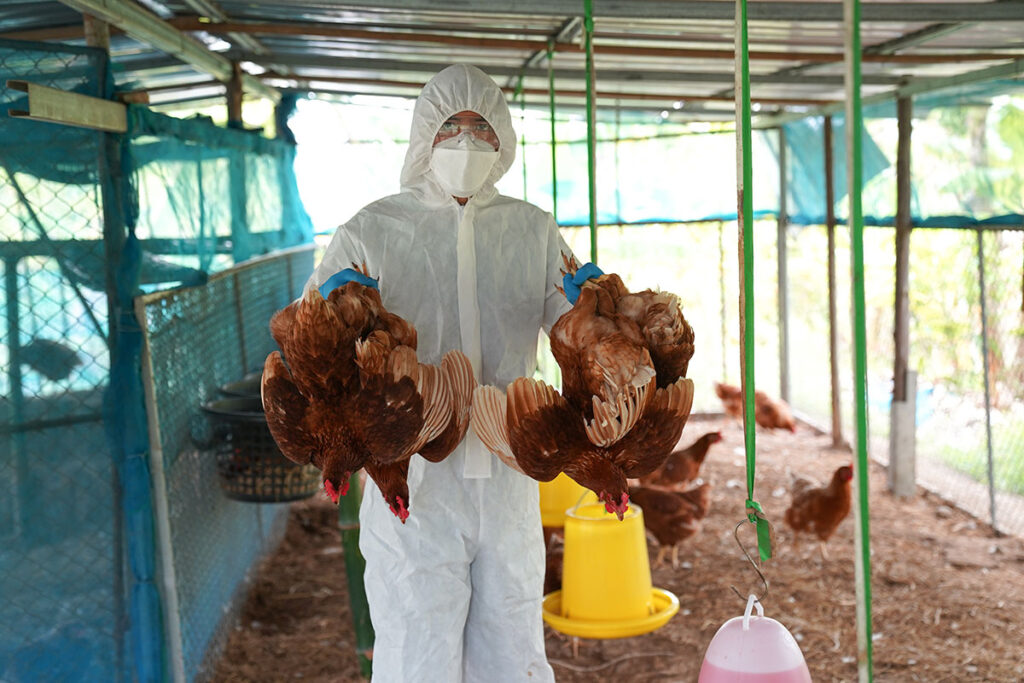Between January and July 2025, Cambodian health authorities reported 11 laboratory-confirmed cases of human infection with avian influenza A(H5N1), including six fatalities. Notably, seven of these cases occurred in June alone—an unusual monthly spike. These recent infections are part of a broader resurgence that began in February 2023, after nearly a decade without reported human cases in the country. Since that re-emergence, Cambodia has confirmed 27 human infections, with a case fatality ratio (CFR) of 44%.
The recurrence of H5N1 in humans underscores persistent vulnerabilities at the human-animal interface and raises critical concerns about surveillance, biosecurity, and pandemic preparedness in regions where the virus remains endemic in animal populations.
Epidemiological Context and Transmission
The H5N1 virus circulating in Cambodia belongs to clade 2.3.2.1e, formerly 2.3.2.1c, and is known to be highly pathogenic in birds. The majority of human cases in Cambodia have been linked to direct contact with infected backyard poultry, either through handling or culling. Males accounted for 63% of cases in 2025, and infections spanned all age groups, including children under five and adults up to 65 years old. All patients had documented exposure to sick or dead poultry.
Globally, from 2003 through July 2025, 986 human H5N1 infections have been reported to the World Health Organization (WHO), with 473 deaths—reflecting a high CFR of 48%. While human-to-human transmission remains rare, the persistent recurrence of zoonotic infections, particularly in rural and peri-urban settings, continues to pose a latent pandemic threat.
Surveillance, Response, and Public Health Measures
Cambodia’s Ministry of Health, alongside its Ministry of Agriculture and international partners, mobilized national and sub-national rapid response teams to investigate the 2025 outbreak. Their coordinated response included:
- Enhanced surveillance for human and animal cases
- Contact tracing and health monitoring of exposed individuals
- Disinfection measures and movement control in affected poultry areas
- Health education campaigns targeting rural communities
Animal health investigations by the General Directorate of Animal Health and Production (GDAHP) revealed ongoing outbreaks in poultry across eight provinces. Importantly, all 2025 human cases had epidemiologic links to infected birds, with no evidence yet of sustained human-to-human transmission. Nonetheless, the WHO classifies novel influenza A virus infections as having high public health impact due to their potential for rapid evolution and pandemic spread.
Clinical Considerations and Diagnostic Tools
Human infection with H5N1 can present with a range of symptoms—from mild respiratory illness to severe pneumonia, encephalitis, and multi-organ failure. Some cases may remain asymptomatic despite known exposure. Laboratory confirmation, typically via RT-PCR, remains the gold standard for diagnosis.
Antiviral treatments such as oseltamivir and zanamivir are effective when administered early, ideally within 48 hours of symptom onset. However, public awareness, timely care-seeking behavior, and access to diagnostics remain barriers in many affected areas.
Vaccine Readiness and One Health Imperatives
Current seasonal influenza vaccines offer little to no protection against H5N1. While some countries have developed and licensed H5 candidate vaccines, these are not widely deployed or stockpiled. WHO maintains a list of zoonotic candidate vaccine viruses (CVVs) and updates its risk assessments regularly based on new genetic and antigenic data.
Cambodia’s response reflects growing adherence to One Health principles—coordinating efforts across human, animal, and environmental health sectors. Continued investment in surveillance, laboratory capacity, and veterinary services is essential to contain outbreaks and prevent international spread.
Implications for National and Global Health Security
Although the WHO currently assesses the risk to the general population as low, the recent pattern of H5N1 resurgence in Cambodia serves as a stark reminder: zoonotic threats remain unpredictable and potentially catastrophic. For the broader public, these outbreaks demonstrate how diseases originating in animals can rapidly jeopardize health security, food systems, and livelihoods—both locally and globally.
Failure to detect and respond to these events early risks enabling silent viral adaptation, including mutations that could facilitate human-to-human transmission. This scenario would have direct implications for pandemic preparedness and national security, emphasizing the urgency of sustained global investment in One Health frameworks, disease surveillance, and vaccine research.
Sources and Further Reading:
- WHO DON: Avian Influenza A(H5N1) – Cambodia (5 July 2025)
- WHO Global Influenza Programme
- Zoonotic Influenza and Candidate Vaccine Viruses
- Cambodian Ministry of Health Press Release (1 July 2025)
- FAO: Evidence-Based Risk Management in Livestock Systems
- WOAH World Animal Health Information System (WAHIS)
Disclaimer: This article is for informational purposes only and is not intended to provide medical advice, diagnosis, or treatment. Readers should consult a qualified healthcare professional for medical concerns.


